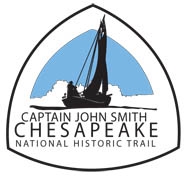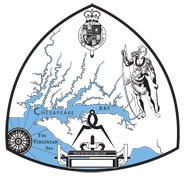

Come on a journey to remember and commemorate
the history and travels of Captain John
Smith!
Over four
hundred years ago, Englishman John Smith and a small crew set out
in an open boat to explore the Chesapeake Bay. Between 1607 and
1609 Smith mapped and documented nearly 3,000 miles of the Bay and
its rivers. Along the way he visited many thriving American Indians
communities and gathered information about this “fruitful and
delightsome land.” In December 2006 the U.S. Congress
designated the routes of Smith’s explorations of the
Chesapeake as a national historic trail—the first national
water trail.
Are you ready
to follow in the wake of Captain John Smith? Visit sites along the
National Historic Trail and learn about the native cultures and the
natural environment of the 17th-century Chesapeake through the
Captain John Smith Chesapeake Geotrail. The Trail provides
opportunities for you to experience the Bay through the routes and
places associated with Smith’s explorations. Caches will be
located in museums, refuges, parks, and towns in Virginia, Maryland
and Delaware along the rivers and creeks that Smith and his crew
explored four centuries
ago.
The Captain
John Smith (CJS) Geotrail launched June 4, 2011 with over 40 caches
within Maryland, Virginia and Delaware. A trackable geo coin will
be awarded to the first 400 geocachers, while supplies last, for
locating at least 15 CJS caches. To be eligible for the coin,
geocachers must download a passport from either the CJS Geotrail or Maryland Geocaching Society website.
Geocachers must find and log at least 15 finds, record the code
word from each cache on their passport and post a picture of
themselve at each cache location. After discovering the 15 required
caches, geocachers may have thier passports validated in person or
via mail at the National Park Service, Chesapeake Bay Office
located at 410 Severn Ave, Suite 314, Annapolis, MD 21403. Please
refer to the passport for complete validation instructions.
Participating in the CJS geotrail is fun and we
hope that many people join in. However, it is not a requirement for
logging your find on this cache once you find the container.
You
are seeking a traditional hide. A Lock & Lock stocked with a
variety of items. Please no night caching at this location! The
park has seasonal hours of operation but is open year round and is
free of charge.
Summer Schedule: April 1 through October 31: Monday – Sunday,
Holidays – 8:00am – 8:00pm
Winter Schedule: November 1 through March 31: Monday –
Sunday, Holidays - 10:00am – 5:00pm
Note: Old Mill Park may be closed during inclement weather or due
to conditions considered hazardous to the publics safety.

Old Mill Park
“Fall
Line”
Located on the shore of the Rappahannock, Old Mill Park in
Fredericksburg features soccer fields, picnic shelters, restrooms,
playgrounds and river views. Swimming is not prohibited but is
strongly discouraged because of swift river currents. The park is
open from 8 am to 8 pm April through October and from 10 am to 5 pm
November through March. Horn blasts announce to park users that the
gates will soon be closing at the end of a day and cars should be
moved before they are locked in for the night.
Fredericksburg lies near the Fall Line, marking the point where the
Rappahannock River descends from the upland to the lowland. A fall
line is typically the furthest reach of navigable water. Towns were
often settled at a fall line since the “fall” of water
from the upland created an energy source to supply water mills,
grist mills and saw mills. Mill products could then be loaded onto
boats for transfer downriver. In the colonial era, Fredericksburg
was a prominent port in Virginia. Fredericksburg developed as the
frontier of colonial Virginia shifted west out of the coastal
plain. The land on which the city was founded was part of a tract
patented in 1671. The Virginia General Assembly established a fort
on the Rappahannock in 1676, just below the present-day city.
In late August, 1608, Captain John Smith and his crew explored the
upper reaches of the Rappahannock. Along for the ride was Mosco, a
Patawomeck Indian with apparent European ancestry who offered
enthusiastic help to the English on the Potomac as well as the
Rappahannock. At a spot close to present-day Fredericksburg, the
men disembarked from the barge and went ashore, “digging in
the earth, looking of stones, herbs, and springs.” After
about an hour, a surprise attack by 100 Mannahoac Indians came,
arrows flying while Smith and his men returned fire. The Indian
warriors withdrew but left an unconscious man behind, whom Smith
ordered that his men pick up and take to the barge to treat him.
Mosco questioned the man who gave his name as Amoroleck and his
tribe as Hassinunga, well upriver at the fork of the Rapidan and
the Rappahannock rivers. Smith wanted to know what lay beyond the
hills above the fall line; but Amoroleck only knew that there were
mountains.
That evening, Smith ordered that Massowomeck shields be affixed to
the barge to deflect any arrows that might be shot at them. Sure
enough, that night an attack came from reinforced Mannahoac
Indians. Smith ordered to let the barge drift downstream and the
Mannahoac followed. At daybreak, the English untied the shields to
let themselves and their unharmed “prisoner” be seen.
Amoroleck called out and assured his tribe that he was okay and
that the English were good people. The Mannahoac hung their weapons
on trees and sent two warriors to swim to the boat with a bow and a
quiver of arrows to present to Smith.
 Thanks to Barkfeather for helping with this hide and to the
Maryland Geocaching Society for assisting with this
project!
Thanks to Barkfeather for helping with this hide and to the
Maryland Geocaching Society for assisting with this
project!